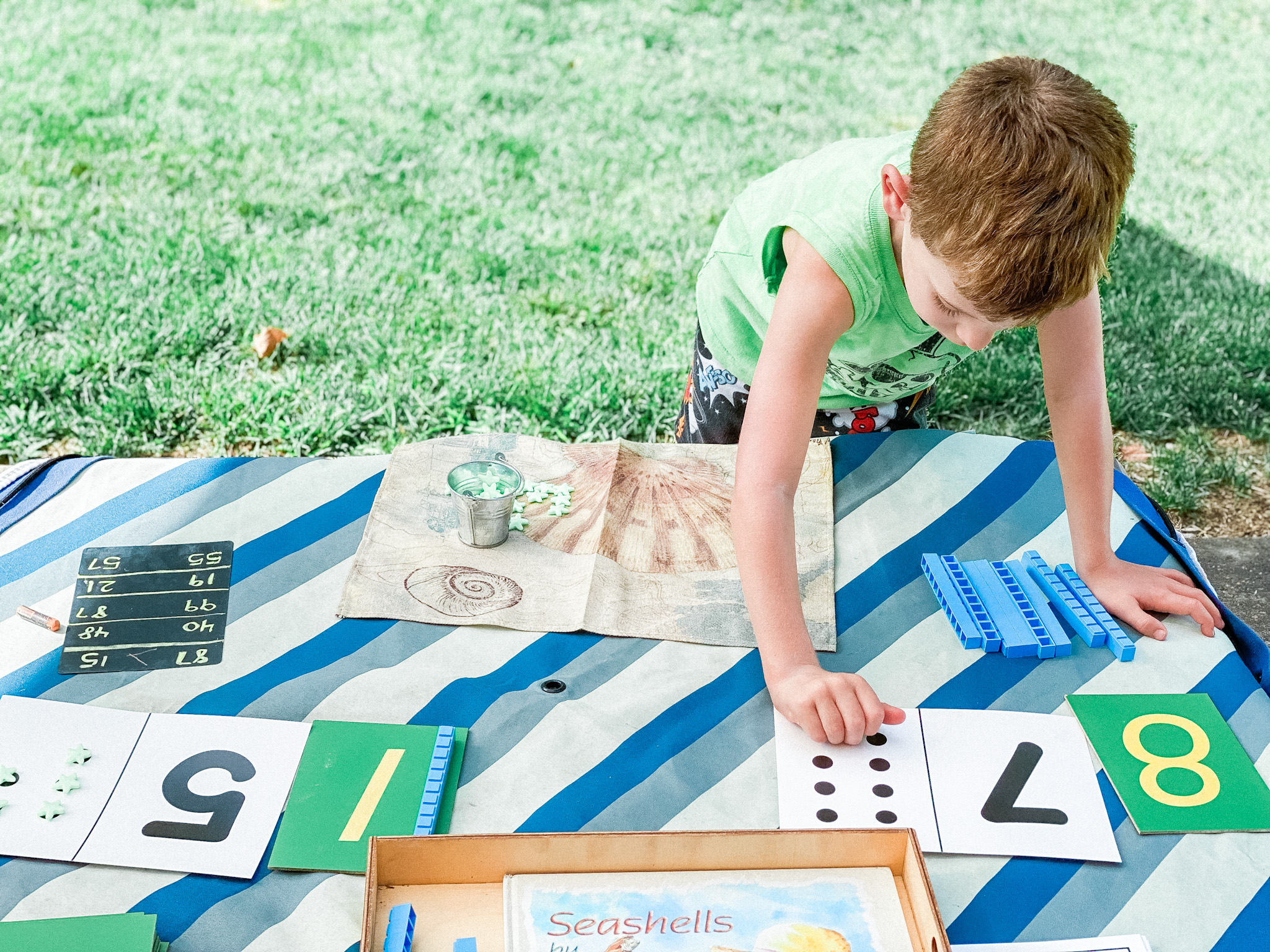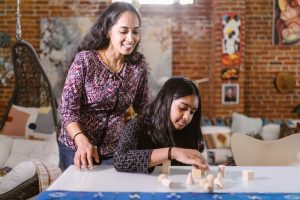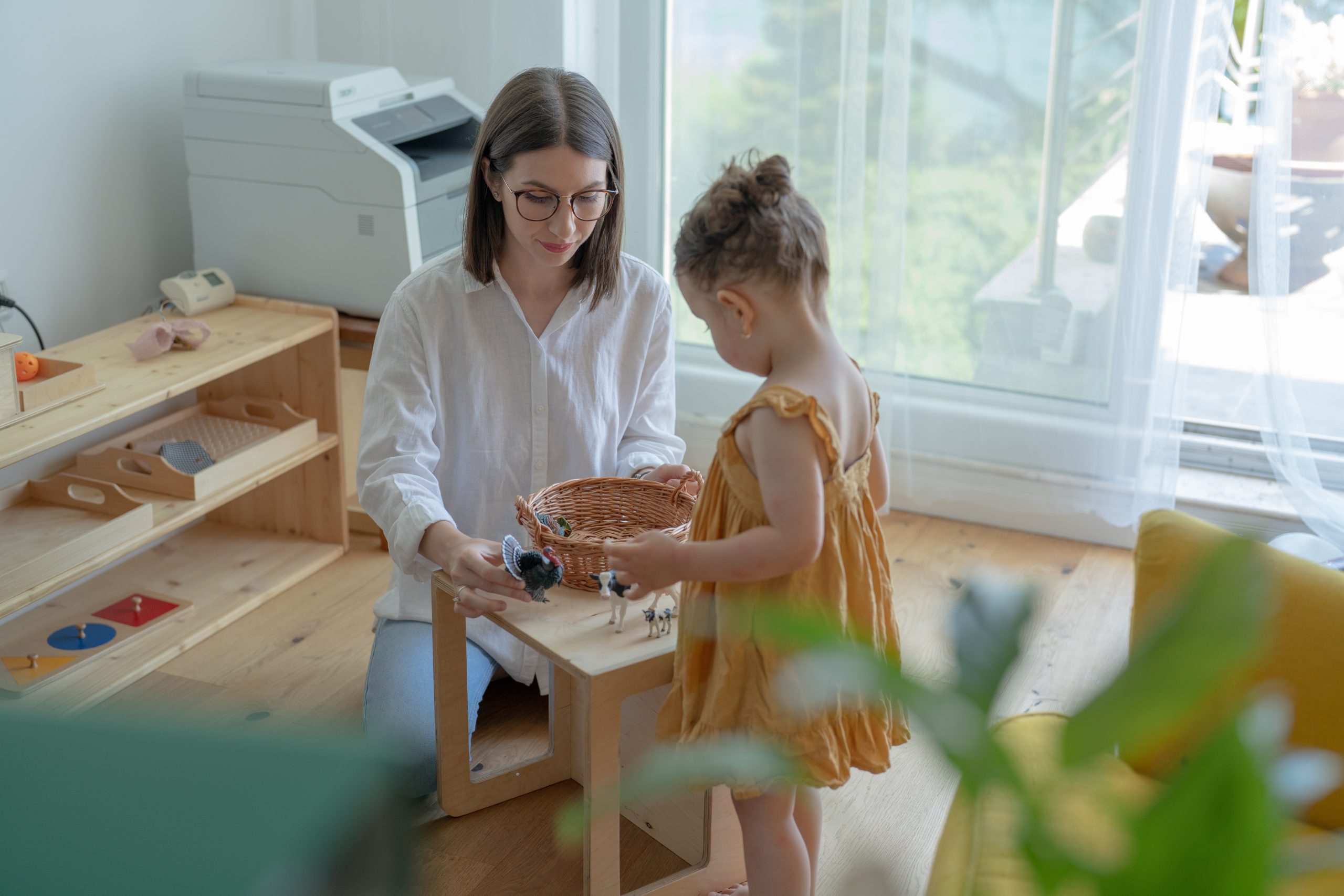Montessori Homeschool
Montessori homeschool gives children and families the best of both worlds. The hands-on materials and game-changing principles of Montessori? Check. The academic flexibility and unparalleled family time of homeschool? Check and check.
With benefits like these, it’s no wonder that more and more parents are interested in making Montessori homeschool a reality for their families.
However, we know homeschooling can feel overwhelming at first. How do you start? Where can you find a good curriculum for your family? How do you prepare your home, routine, and child for success?
In this guide, we answer all these questions and more. We’ve laid out our best tried-and-true Montessori homeschool tips to help you feel empowered, confident, and ready to begin your homeschool journey. For parents who are hungry for even more knowledge, we’ve also given you exactly where to look to learn more.
If you’re here, we know you’re ready to get started. So are we. Let’s do it!

Montessori Homeschool Principles
Before we dive into the details of routines, curriculums, and lessons, there are a few basic Montessori principles that lay the groundwork for a successful Montessori homeschooling experience. These core principles act as the backbone of the Montessori method. The materials, environment, and curriculum all rely first and foremost on Montessori principles, a few of which we’ll briefly cover here.
 For one, Maria Montessori believed children have absorbent minds. She observed they took to learning with ease, absorbing information, language, and culture like a sponge. Dr. Montessori also believed strongly in the prepared environment that allows the environment itself to become the teacher.
For one, Maria Montessori believed children have absorbent minds. She observed they took to learning with ease, absorbing information, language, and culture like a sponge. Dr. Montessori also believed strongly in the prepared environment that allows the environment itself to become the teacher.
The Montessori method advocates for freedom within limits, offering children ample opportunity for freedom of choice, expression, and activity within appropriate boundaries. Just like the prepared environment, the prepared adult is an indispensable aspect of the Montessori approach. Adults should model appropriate behaviors to children, observe them to better understand their needs, respect children, and honor their focus.
In Montessori environments, hands-on learning is key. Dr. Montessori taught, “What the hand does, the mind remembers.” Children direct their own work, receive opportunities to develop their independence, and spend plenty of time in play (preferably outside.)
Here, we’ve barely begun to scratch the surface of Montessori principles. For more in-depth reading, we recommend this comprehensive read on must-know Montessori principles.
Creating a Montessori Homeschool Environment

In Montessori, the prepared environment is about so much more than how you prepare your homeschool room. It’s a powerful tool that can give your children independence, freedom, beauty, routine, and consistency. Here, we’ll share our best tips for creating a Montessori homeschool environment that will empower your child and make your life easier as a homeschooling parent.
First, prioritize accessibility throughout your homeschool space, whether it be a dedicated room in your home or part of your typical living space. Making the area accessible for children can promote their independence, freedom, and confidence.
Next, keep the learning environment organized and clutter-free. In Montessori, there should be “a place for everything with everything in its place.” When possible, fill your homeschool space with natural materials and beautiful items.
Create opportunities for practical life skills throughout your environment, and always remember to follow the child. Let your child’s interests, skills, and preferences guide how you prepare your homeschool environment.
Visit this article to learn more about creating an authentic Montessori homeschool environment.
Establishing a Montessori Homeschool Routine
Children and adults alike thrive on routine. Routines provide children with a sense of stability, security, and control. They help transitions happen more smoothly and can make the home a more peaceful place for everyone who lives there.
The beauty of homeschool is that your routine can be tailor-made to your unique family and needs. There are a few tips, however, that we recommend to all families while establishing a Montessori homeschool routine.
 A prepared environment can greatly facilitate your Montessori homeschool routine. Prioritize consistency and build some non-negotiables, like basic self-care and meals, into your daily routine.
A prepared environment can greatly facilitate your Montessori homeschool routine. Prioritize consistency and build some non-negotiables, like basic self-care and meals, into your daily routine.
Keep in mind that consistency doesn’t mean rigidity. Be open to change when your routine isn’t working or when something needs adjusting. Observe your child and work closely with them to best understand their needs. Champion everyday activities within your daily routine to build your child’s autonomy and life skills.
Click here to find more tips on building a Montessori homeschool routine, as well as specific ideas you can include in your own daily routine.
Montessori Homeschool Resources
 While Montessori homeschool can feel overwhelming, you don’t have to do it alone — there are countless communities and resources that stand at the ready to support you.
While Montessori homeschool can feel overwhelming, you don’t have to do it alone — there are countless communities and resources that stand at the ready to support you.
A few of our favorite local resources for Montessori homeschool families include playgroups and homeschool co-ops, libraries, and thrift stores.
Online communities, used Montessori materials, books, printables, and curriculums are available to parents all over the world.
To read more about Montessori homeschool resources, visit this article.
Montessori Homeschool Curriculum
For many parents, the first question they ask themselves after deciding to homeschool is this: “What about a curriculum?”
An authentic Montessori curriculum can be hugely helpful in planning lesson units, outlining how to use Montessori materials, and teaching techniques like the Montessori three-period lesson.
While you may have the materials ready, the environment prepared, and the principles studied, it can be hard to understand what day-to-day Montessori education looks like without a curriculum.
Here, we’ll answer your top questions about how to find a Montessori homeschool curriculum that works for your family.
What to Look For In a Curriculum
Since the term “Montessori” isn’t trademarked, any curriculum can claim to be Montessori, even if not made with Montessori principles in mind or by a certified Montessori educator.
When considering any Montessori homeschool curriculum, check to ensure it incorporates the principles and approaches of the Montessori method. Investigate the credentials of the curriculum’s creator to ensure you’re getting the real deal.
 Check to see if it covers a variety of subjects and the five traditional Montessori classroom areas: practical life, sensorial, mathematics, language, and cultural studies.
Check to see if it covers a variety of subjects and the five traditional Montessori classroom areas: practical life, sensorial, mathematics, language, and cultural studies.
You can also evaluate the curriculum’s focus on materials. Does the curriculum mostly focus on printables and worksheets, or tactile materials, either store-bought or DIY? A good Montessori curriculum will tell you which materials you need and how to use them in your home classroom.
Finally, ensure the curriculum is flexible and easy to individualize so you can always follow the child. It’s an added bonus if the curriculum includes opportunities for community to ask questions and find support from other parents or educators using the same curriculum!
Read more about choosing the best Montessori homeschool curriculum for your family at this link. You can also visit our guides for Montessori homeschool curriculum for ages 3-6 and Montessori homeschool preschool.
A Note on Local Requirements
Before getting started, make sure you’re aware of your local laws, requirements, and benefits when it comes to homeschool. Some countries ban homeschooling altogether or have strict requirements in place. Homeschool is legal all across the U.S., but laws, requirements, and benefits differ by state. This Time4Learning page on homeschool laws by state can help you become familiar with homeschool laws in your state. There are also resources to get funding for homeschooling.
Let’s Get Started!
Now that you know the basics of Montessori principles, preparing your environment, establishing your routine, and choosing a curriculum, you’re ready to get started with Montessori homeschool.
Remember, you don’t need to be perfect to be an effective homeschooling parent. Children learn from everything they experience, and their absorbent minds make learning effortless. As you focus on your connection with your child and the once-in-a-lifetime opportunity to educate them at home, the rest will fall into place.
You’ve got this!




0 Comments